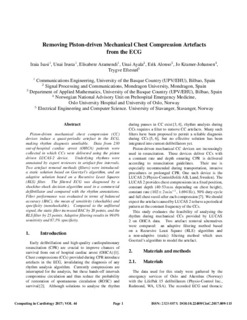
Izenburua
Removing piston-driven mechanical chest compression artefacts from the ECGEgilea
Egilea (beste erakunde batekoa)
Argitalpen data
2017Beste erakundeak
Universidad del País Vasco/Euskal Herriko Unibertsitatea (UPV/EHU)Norwegian National Advisory Unit on Prehospital Emergency Medicine
Oslo University Hospital
University of Oslo
University of Stavanger
Bertsioa
Bertsio argitaratuaDokumentu-mota
Kongresu-ekarpenaKongresu-ekarpenaHizkuntza
IngelesaEskubideak
© 2017 The AuthorsSarbidea
Sarbide irekiaArgitaratzailearen bertsioa
http://dx.doi.org/10.22489/CinC.2017.009-115Non argitaratua
44th Computing in Cardiology Conference, CinC 2017. Rennes, France. 24-27 September. Computing in Cardiology Vol. 44. Pp. 1-4. IEEE Computer Society, 2017Argitaratzailea
CinC Computing In CardiologyLaburpena
Piston-driven mechanical chest compression (CC) devices induce a quasi-periodic artefact in the ECG, making rhythm diagnosis unreliable. Data from 230 out-of-hospital cardiac arrest (OHCA) patients we ... [+]
Piston-driven mechanical chest compression (CC) devices induce a quasi-periodic artefact in the ECG, making rhythm diagnosis unreliable. Data from 230 out-of-hospital cardiac arrest (OHCA) patients were collected in which CCs were delivered using the piston driven LUCAS-2 device. Underlying rhythms were annotated by expert reviewers in artefact-free intervals. Two artefact removal methods (filters) were introduced: a static solution based on Goertzel’s algorithm, and an adaptive solution based on a Recursive Least Squares (RLS) filter. The filtered ECG was diagnosed by a shock/no-shock decision algorithm used in a commercial defibrillator and compared with the rhythm annotations. Filter performance was evaluated in terms of balanced accuracy (BAC), the mean of sensitivity (shockable) and specificity (nonshockable). Compared to the unfiltered signal, the static filter increased BAC by 20 points, and the RLS filter by 25 points. Adaptive filtering results in 99.0% sensitivity and 87.3% specificity. [-]
Bildumak
Item honek honako baimen-fitxategi hauek dauzka asoziatuta:





















